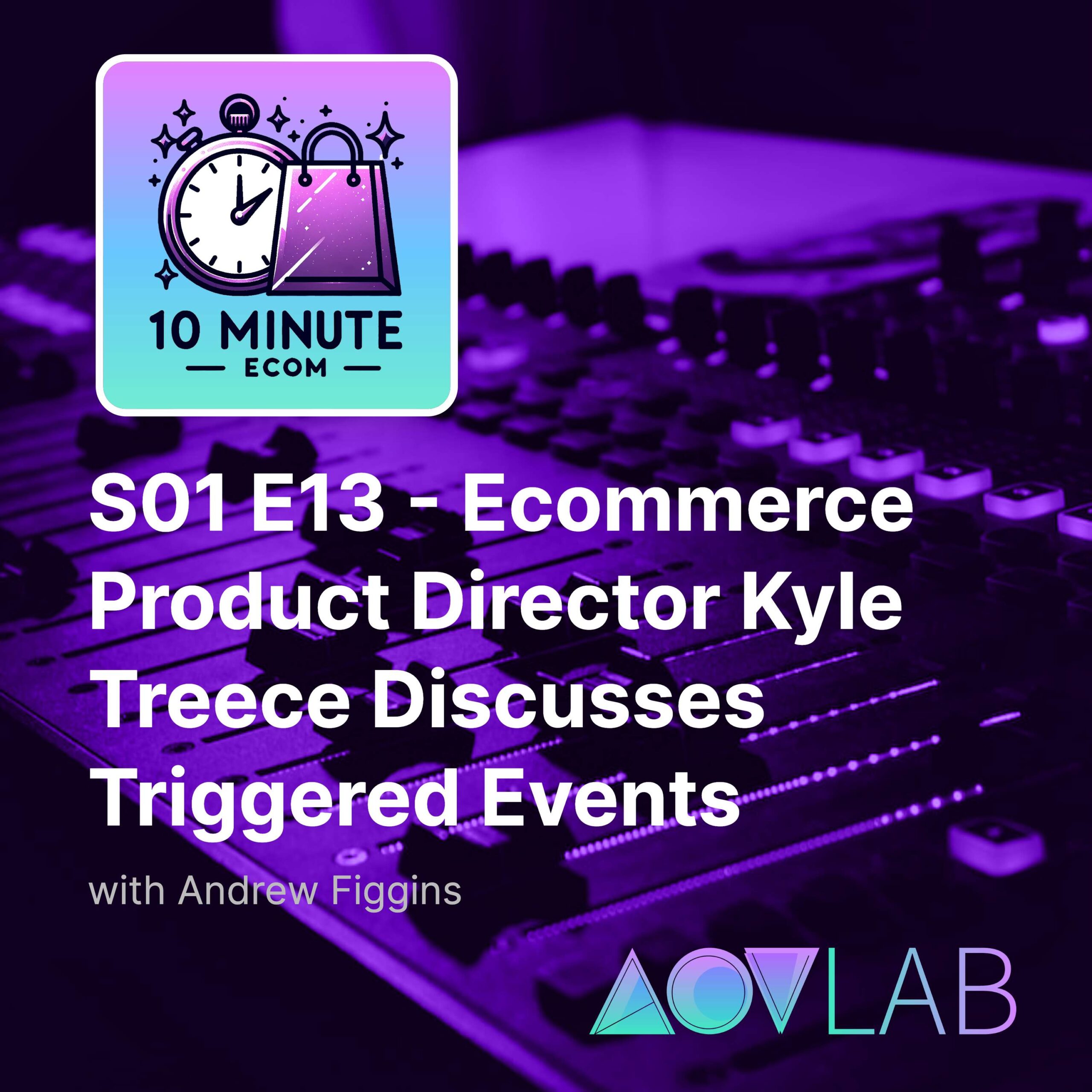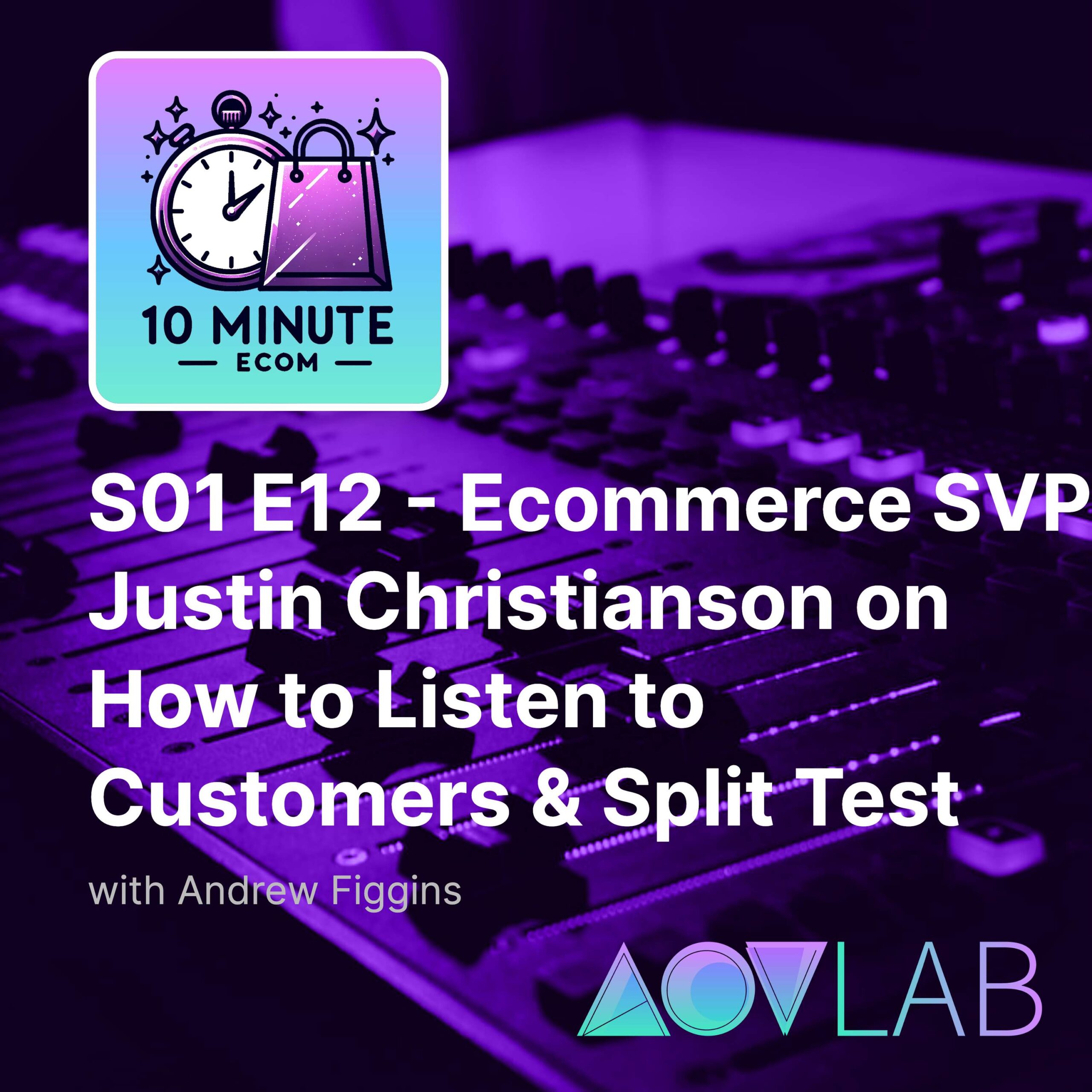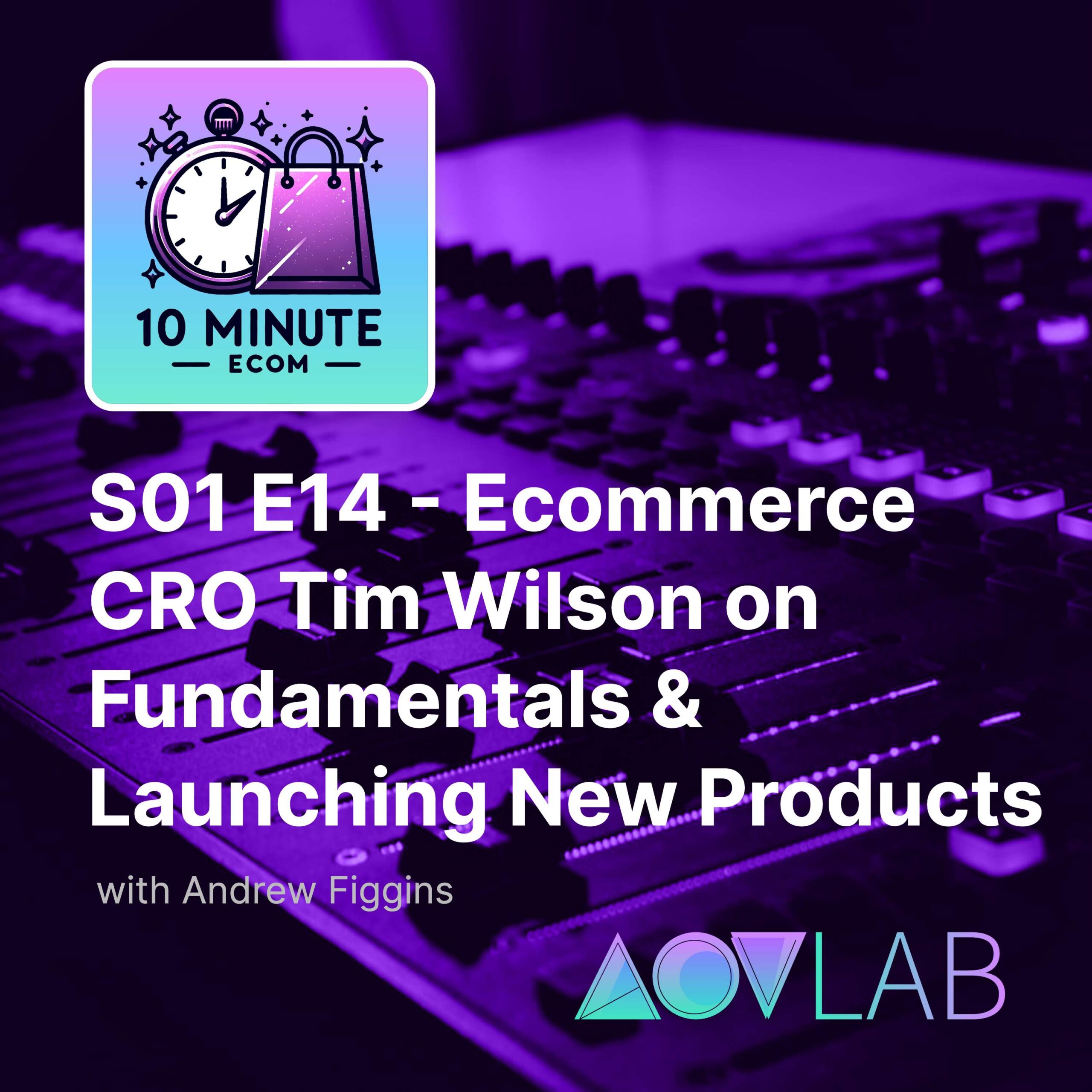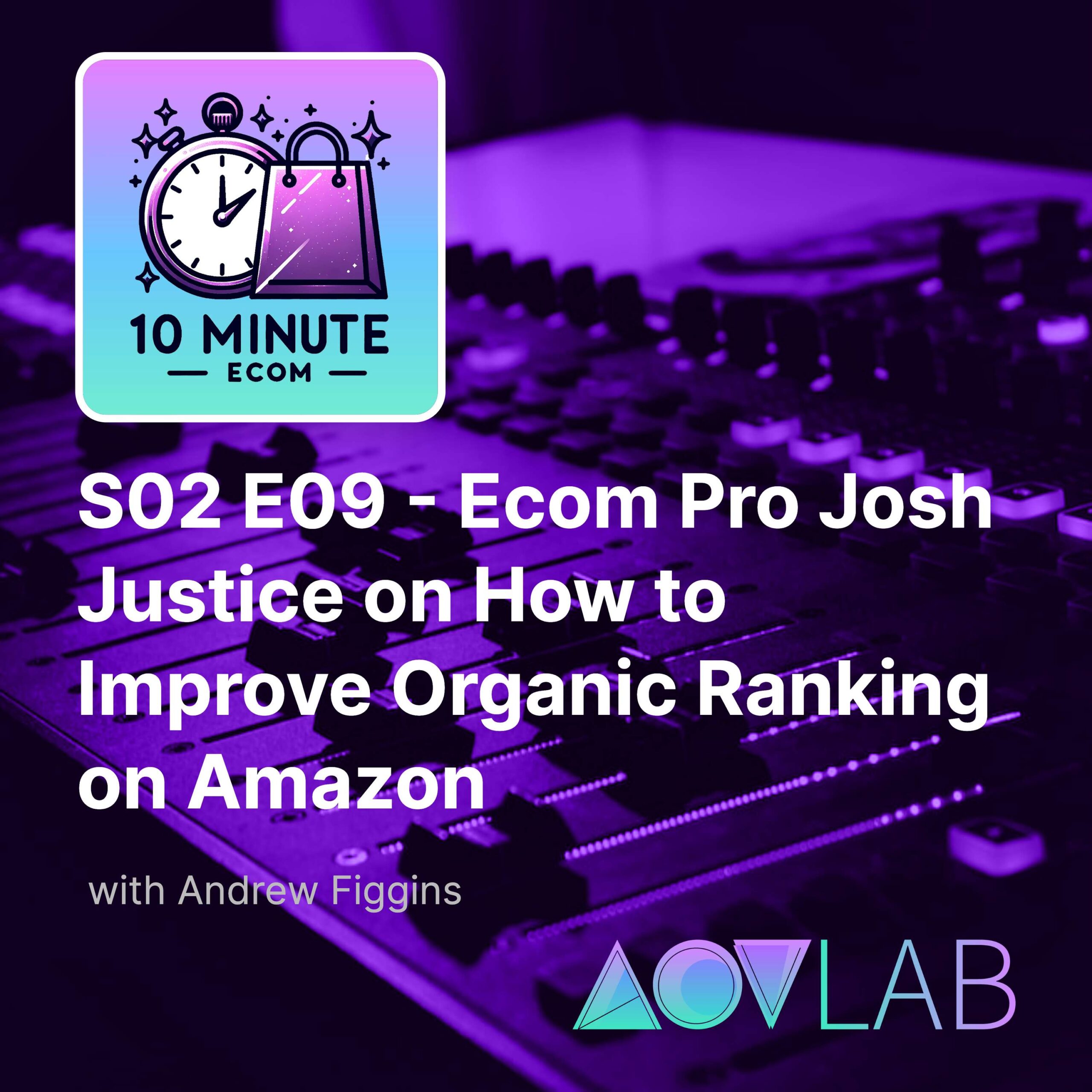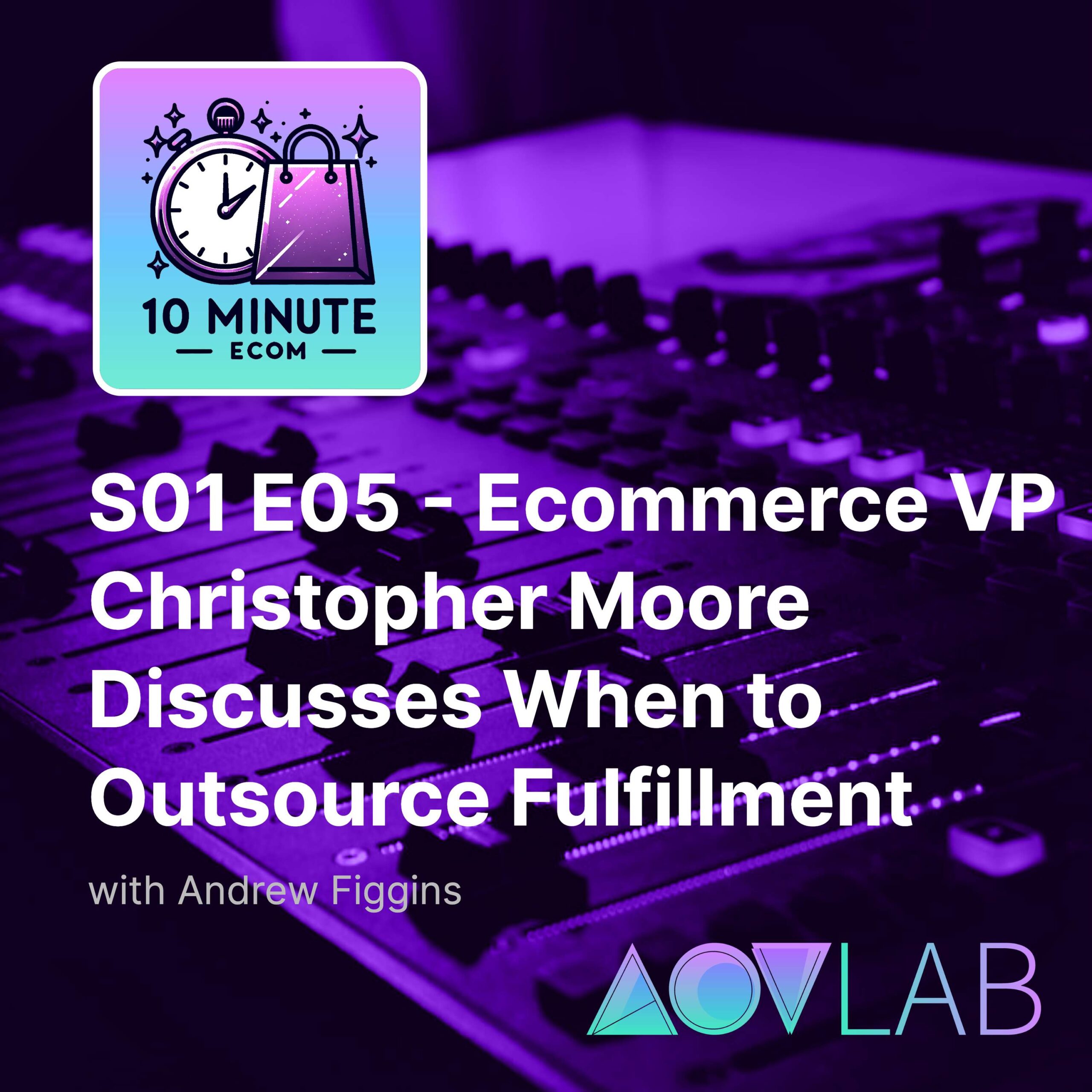Guest: Kyle Treece, Director of Product Management, Bed Bath & BeyondHost: Andrew Figgins, Founder, AOV Lab Episode Synopsis:Kyle discusses how triggered events form the foundation of Bed Bath & Beyond’s effective customer identification and personalization strategy. Transcript: [00:00:15] Andrew: Hello Ecommerce fans, and welcome to 10-Minute Ecom, an AOV Lab podcast. Every episode, we break down a new and different tactic that can help you improve your ecommerce KPIs (key performance indicators). I’m your host, Andrew Figgins, and like most of you, I am an e commerce professional. You may know me as the founder of AOV Lab, the former VP […]
View Full Transcript
Episode Transcript
[00:00:12] Speaker A: Hello, ecommerce fans, and welcome to ten minute Ecom and AOV Lab podcast. Every episode, we break down a new and different tactic that can help you improve your ecommerce KPIs key performance indicators. I'm your host, Andrew Figgins, and like most of you, I am an e commerce professional. You may know me as the founder of AOV Lab, the former vp of digital product innovation at Scrubs and beyond, as the former director of ecommerce technology at Royal King, or just from LinkedIn today I'm excited to be talking to Kyle Trees, an e commerce peer, with a really cool tactic that I'm eager for him to introduce. Kyle, what did you bring on the show today to share with your e commerce colleagues?
[00:00:55] Speaker B: Yep, Kyle trees here. I've spent the last almost six years at Bed Bath and Beyond, which formerly was Overshock, acquired the digital properties of Bed Bath and beyond this summer in 2023. So we've since rebranded to Bed Bath and beyond, and I'm based out of Salt Lake City, specifically South Jordan. The tactic or idea I wanted to bring to you today was specifically around the evolution of our triggered events and tactics that we utilized at Bed Bath beyond. And by triggered event, I would mean something very specific to a user behavior, action, or characteristic that we've seen.
[00:01:35] Speaker A: Thank you, Kyle.
[00:01:36] Speaker C: After the ad, we'll get right into the chat.
Today's episode of ten minute ecom is brought to you by Optiversal. Optiversal provides aigenerated SEO landing pages that can help you rank and earn organic traffic for keywords you don't currently rank for. Their software is being used by some of the premier brands in ecommerce like Best Buy, Petco, and Tractor Supply Co. I was Optiversal's customer at Scrubs and beyond and saw firsthand how Optiversal started from scratch and built a multimillion dollar organic traffic channel. Their technology, 100% works. Go to aov lab.com and click on Vendor network to set up your 30 minutes discovery call with Optiversal. And now back to the show.
[00:02:28] Speaker A: Kyle, tell me about this in some detail. Where did the idea come from and.
[00:02:32] Speaker D: How does it work?
[00:02:34] Speaker B: Our recent change in CMO has left our current retail president as our CMO. But our former CMO, her name was Angela sue. She came from almost, I think, 20 years at Lamps plus. She was very driven around triggered content, and I think her reasoning being a marketer was how can we make things more meaningful for the people who are interacting with our site and our brand in a way that kind of helps them find what they're looking for, but quicker than had they otherwise been unguided in general. And so we had a strong CDP implementation with mparticle, and one of our former senior directors of analytics had made a lot of progress in some probabilistic matching with customers using email addresses to the point where prior to his kind of alterations into how we would approach who this customer was, we could identify about 20% of the people hitting our website. And that number had moved and grown to just over 50% in the space of about six months. And the benefit from the product side is that opened a lot of doors because the kind of data we were collecting about these customers would be simple and at the same time advanced. What subcategories were they shopping? How many product pages had they shopped? Some of the integrations with Google give us external information about how likely they were to be in the purchase phase of their purchasing lifecycle in general. And so we started really simple and luckily we were a promotional company, so we had levers that not all companies have.
[00:04:17] Speaker A: I'm curious, so I have to ask this, how did being a promotional company.
[00:04:21] Speaker D: Come into play here?
[00:04:23] Speaker B: One of the easiest ones was our coupons, and so one of our first implementations that was on the website, we were doing this in email. In general, I think most large companies have some slight structure behind having content that's a little different depending on who you are. But we utilized one of our coupon offers and built a triggered event that basically said if somebody had added something to cart, ended their session, and then was restarting their session, let's give them a fly out like experience that reminds them that they left this product in cart and incentivizes them to purchase today with a 24 hours coupon that would expire had they not used it within the day. And that was really just like a first one of our easy ones. We a b test everything that a b test produced. A three point, I think 3% lift in conversion, which general a B tests are set to be detecting anywhere between zero point 75 and 1% lift in conversion. So to see a 3.3 was massive. And the interesting thing was marketing owns our spend, so how much we're having to discount to orders and purchases. When we proposed this solution, they were definitely very concerned because they're like, hey, you're going to get 15% off someone whose propensity is already fairly likely and they've shown their interest. By adding an item to cart. We might be basically cannibalizing our own income margin with this kind of feature. The interesting thing was we didn't do that. Now that could be by way of we're frequently very promotional, so things are on sale all the time and maybe the products getting added were already on sale and you don't double your coupon spend with any promotional spend. But it was just a very interesting start to saying, here's this feature. And we set it up with a feature flag so it could be turned on or off as often as they wanted and led to a number of additional hypotheses that the teams have started expanding on. Whether it's a basic content card of looking for rugs, because we saw you shopping for rugs, some of the psychological balance that comes with low inventory. This product that you looked at is now trending in sales, and it was all structured via this little hub in the header of bed bath beyond that's titled currently notifications. Although we were working to advance what that was seen of, which has now become this place where customers can find content that's relevant to them. So it's a very interesting singular use case that I know the teams are still working on expanding because it holds a lot of opportunity.
[00:07:04] Speaker D: Sounds like it's very unique to bed Bath and beyond. And yet I know a lot of retailers, a lot of Ecom companies are absolutely in this space of trying to identify this huge number of people, this huge group of people that just, I.
[00:07:19] Speaker A: Don'T know, call them in the middle.
[00:07:21] Speaker D: Like they're on the website. Maybe they haven't quite identified themselves yet, but typically that can be 80% or so, 90% even of a website's visitors. What are some ways, if you can share, what are some ways to actually identify those folks? And how valuable was it when you guys figured out how to identify that people?
[00:07:44] Speaker B: So one of the easiest ways is making sure that you have a value proposition that incentivizes giving your email to you. So ours was email sign up placements where our value proposition was we're sending coupons daily and as a matter of fact, our lead capture rate, it's a line item in my resume. One of the things I was most proud of when I came in, we were capturing approximately one and a half percent of our visitors email addresses. And at the time, we basically had two coupon types. It could be something like a percent off or an AOS coupon is what we call. So if you spend $300, you get 50% off. In the last three years, we'd expanded to offer up to six coupon types. It could be a coupon for a singular specific product, a coupon that is relevant only to a category coupon that's relevant to a partner in general. So we have a number of different brands. We had stackable coupons so you could add the coupon savings on top of the actual promotion. And then we had a single item coupon as well. So you might go richer and set 2020 5% off, but it's limited to one item. Expanding those value propositions for that call to action led us to the point where we were having anywhere between three to 4% lead capture rate. And with a company that sees a million to 2 million visits a day, that's a massive expansion from one and a half percent. So I think that's a primary thing that is organic, right? You're not cheating the system, you're not data collecting, you're openly and transparently saying, we'll give you some value for this information. And some companies do it better than others. But account creation is also another approach. Hey, you have better order tracking status. We'll make your content. A lot of companies say your content will be more relevant if you create an account. I don't know how true that always is, but it's a value proposition. And if you can deliver it and prove to the customer that's the case, I think that's another way. And then last, we were heavily influenced in terms of our marketing channels by Google. And for most people who've worked in ECoM, you know that Google has a pretty robust tag marketing tag. And so being able to feed some of that information into our cdp was also extremely valuable for us. And I think because we did so much marketing for Google, it did heavily expand what we were doing. As far as how much, I don't remember the exact way you phrased it, but what kind of value did that produce? It's really hard to measure because you're changing your marketing tactics all the time. So where your spend is going and what results, what kind of traffic that's bringing. And you can't really a b test going from probabilistic match rate of 20% to 50% because you just start implementing that and seeing what happens. But I can tell you a number of the site AB tests is how you would frame it. A number of the AB tests that we ran, which I can recall maybe 15 to 20 offhand, those tests would typically see a win rate between 60 and 70%. Where if you're looking at just like general AB experimentation for our feature development in terms of how the website looks and where things are positioned and the wording, background, the design, all your win rate is usually 35% to 45%. So you do have a much higher likelihood of providing meaningful value to your customer when it's something that's specific to them. And I don't know if that's a good enough answer, but it's as close as I can get for you.
[00:11:29] Speaker D: Yeah, absolutely. I appreciate it. Something just based on one of the words you used a couple of times in your answer, you got me thinking a little bit this morning, Kyle, and we talked about this a little bit before we started recording, but just that meaningfulness, and not necessarily in a value ecom way, but what are some ways that you felt like your work delivered meaningfulness to your customers and maybe even to some of your team members?
It's a different question, but figured I want to ask that type of question of you.
[00:12:04] Speaker B: Yeah, it is a good question. It's a tricky one, in my opinion, with ecommerce, because it's not a singular solution that only you are offering in general. One of the easiest ways for me to explain what I saw to be a valuable ecommerce implementation was when Instagram really expanded their personalized advertising. Because I shopped a lot from, it was constantly goods that were relevant to my lifestyle. Camping stuff, snowboarding gear, stuff for kids. If my kids had been on my phone playing around, and it was relevant to them. And so thinking back to the initial tactic I brought to you and your question, just barely helping people understand that the more relevant you can make some piece of content to the customer is going to ease the burden of shopping pain. And if anyone's ever shopped online for a large ticket item, it can be scary almost. It can take a lot of time. You can almost buy six times and back out every time. You can check your cart daily for 30 to 60 days.
No one wants to mess up that experience. And so I think helping people ensure that they can push that order now button and then three weeks later end up being happy that they pushed it. And not unhappy reduces a lot of stress. And anyone who's ever had to return something, especially like a larger item, it's not easy, unfortunately. Now, granted that space is evolving, you look at Amazon and what they're doing for returns, I think that's one of the reasons. Not the only reason, but one of the many reasons. Amazon has just blasted up in terms of retail because they've made returns so easy. And it's such a big problem. The other example I would use, and we were talking about this a little bit earlier on the call, this is how I would lean into my teams without trying to convince them of something they didn't believe, mind you. Right. It was just here's my take on why it can be meaningful is as a not customer target Persona of the overstock bed, bath and beyond customer base, but someone who shop and spend money on the site fairly frequently, more frequently, probably, than I should have. I've seen spaces in my home or places I've lived go from we never go into that room, we never sit in that area. We hang out on the couch inside to we're hanging out outside because we have this wonderful space. We bought a fire pit and now we're hanging out by the fire when we never were before. And I think that just maximizes the utility of what customers are looking for by finding a product on your site. And I think that's meaningful enough to say you can get behind that kind of value proposition. In general, it might not be meaningful enough for everybody. There's people who really want deep rooted meaning in what they do and that might not work for them. But having experienced that myself and said our backyard that was never used turned into an additional 500 space that we hang out, that's maximizing my utility and I think that's beneficial to all customers who shop and we help them find something that makes them feel the same way.
[00:15:22] Speaker D: Awesome. I'm going to take a little leap here, Kyle, and ask you, for people who are working in e commerce, what's a way for us to maximize our utility? Maybe in the same way as that patio set, but there's a lot that goes into e commerce work. There's the data side of it, there's the analytics side, there's the art of it, a b testing and iteration that you've mentioned.
How do we maximize our own utility as ecom people?
[00:15:55] Speaker B: I do think it all starts by really understanding who your customer is and understanding that the customer problem or customer benefit doesn't just stop when they order on your website. I think a lot of times from the business side, that's all that's ever talked about. How many orders did we get yesterday? What was conversion yesterday? What was average order size? And so you might find yourself monitoring those metrics, trying to improve them. Let's say you see a 5% jump in a month because of work that you've done. I just don't think that's enough to say at the end of the day, hey, I really feel happy about what I'm doing. That's like a business outcome. Right. It's not meaningful. I think you brought up that you had worked previously at a tractor sales place. I want to say, I think there's members of my family who are farmers, and that's how they make their living. And thinking about tractors, I know one member specifically has very high tech tractors on his farm, to the point where it's like programmed gps and the tractor goes and does everything. Somebody sits in there, but they don't do anything. They just sit there. For that individual, getting a new tractor that did and didn't have gps, for example, means he can pay either people less or have less people in general. He'll be more profitable, his farm will be easier to manage. And that's a massive load of stress off of their shoulders because of a product you purchase. So I think that's the other aspect is just making sure you really understand, why am I selling what I'm selling? And I'm sure there's products where that's not always possible, to a point where it's like, hey, his life is better because he can make more money and run a more profitable farm with less stress, for example. I get that. But I think understanding that no matter what product you're selling is the one way that you can come out of every day saying, hey, I'm doing something meaningful that's really trying to. And for me, if I was working at a tractor company, I don't know that my utility would be maximized because tractors are out of scope for my world of living in a city. Right. But knowing that the people I'm selling to are going to be more operationally functional and more profitable as a result, I think having that mindset should be standard product in general, standard ecom business owner objective to make sure you understand that, but believing that you understand it and taking it past the point of sale measurement, and you know what I'm saying, like, getting into lifestyle change that your product causes, I think, is the primary way that I would recommend getting there.
[00:18:40] Speaker D: Awesome. Yeah, that makes total sense to me. I was going to make a joke about what if the tractor has two snowboards on it and it's going downhill and it's powered by electricity or something? That would be pretty cool. Maybe that's the kind of tractor that will be right up your alley, Kyle.
[00:18:55] Speaker B: Sounds good to me.
[00:18:57] Speaker D: Awesome mail. Thanks so much for stopping by today. It's a brief show. Ten minute ecommerce, the name true to form. It's only ten minutes or so of us chatting. Is there anything else that you'd like to share with your ecommerce colleagues before heading out today?
[00:19:13] Speaker B: No, nothing specific comes to mind other than best of luck out there.
[00:19:18] Speaker D: Absolutely. Yeah. I think we all need it. It's a tough year in 2023, heading into 2024. But again, Kyle, thanks so much for coming on. I think I took a lot of inspiration from today's episode, so thank you.
[00:19:32] Speaker B: Ned. Thanks for having me. Andrew.
[00:19:34] Speaker A: That's just about going to do it for today's show. If you have a moment, be sure to subscribe, like, or follow the show on Apple Podcasts, Spotify, Amazon Music, Google Podcasts, or wherever it is that you listen. You can also leave a rating and review of the show in your podcast app. I really hope you enjoyed this episode. Until next time, this is Andrew Figgins signing off and saying, have a good one. But.
